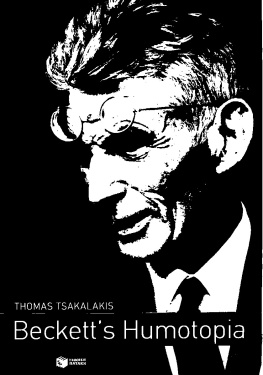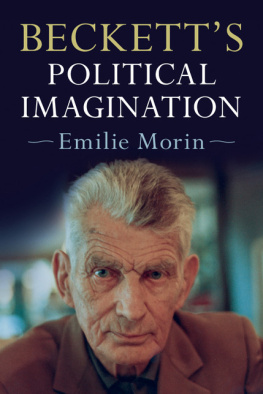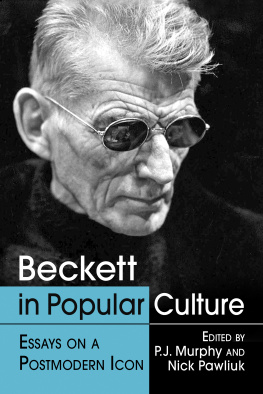TEN WAYS OF THINKING ABOUT SAMUEL BECKETT: THE FALSETTO OF REASON
Enoch Brater is the Kenneth T. Rowe Collegiate Professor of Dramatic Literature at the University of Michigan. He has published widely in the field of modern drama, and is an internationally renowned expert on such figures as Samuel Beckett and Arthur Miller. His seminal studies on Beckett include Beyond Minimalism: Becketts Late Style in the Theater (Oxford University Press, 1987); The Drama in the Text: Becketts Late Fiction (Oxford University Press, 1994); Beckett at 80/Beckett in Context (Oxford University Press, 1986); and The Essential Samuel Beckett (Thames & Hudson, 2005).
TEN WAYS OF THINKING ABOUT SAMUEL BECKETT: THE FALSETTO OF REASON
Enoch Brater

Bloomsbury Methuen Drama
An imprint of Bloomsbury Publishing Plc
50 Bedford Square | 175 Fifth Avenue |
London | New York |
WC1B 3DP | NY 10010 |
UK | USA |
www.bloomsbury.com
First published in Great Britain in 2011 by Bloomsbury Methuen Drama
Enoch Brater 2011
Enoch Brater has asserted his right under the Copyright, Designs and
Patents Act, 1988, to be identified as author of this work.
All rights reserved. No part of this publication may be reproduced or transmitted in
any form or by any means, electronic or mechanical, including photocopying,
recording, or any information storage or retrieval system, without prior
permission in writing from the publishers.
No responsibility for loss caused to any individual or organization acting on or
refraining from action as a result of the material in this publication can be
accepted by Bloomsbury or the author.
Visit www.bloomsbury.com to find out more about our authors and their books
You will find extracts, author interviews, author events and you can sign up for
newsletters to be the first to hear about our latest releases and special offers.
British Library Cataloguing-in-Publication Data
A catalogue record for this book is available from the British Library.
eISBN-13: 978-1-4081-3723-9
Library of Congress Cataloging-in-Publication Data
A catalog record for this book is available from the Library of Congress.
For Hersh, Toby, Linda, Porter, Toi and Stan
Clov No one that ever lived thought as crooked as we.
Hamm We do what we can.
Endgame
PREFACE
Beckett and a Way of Thinking
Beckett is the last writer to shape the way we think and feel.
Don DeLillo, Mao II
In one of those great passages from the novel Molloy, the kind that reminds you why you read Beckett in the first place, the story telling, such as it is, is abruptly stopped in its tracks when a Keatsian reminiscence of things recently past oddly intrudes:
Do you know what he told me the other day He said to me, said Gaber, Gaber, he said. Louder! I cried. He said to me, said Gaber, Gaber, he said, life is a thing of beauty, Gaber, and a joy for ever A joy for ever, he said, a thing of beauty, Moran, and a joy for ever I said, Do you think he meant human life?
The intercalated dialogue, all talk (like the rest of the fictional enterprise), is of course part of the storytelling too. But it is just as telling in other ways as well, ways that go to the heart of the matter concerning Becketts accomplishment in terms of big-ticket items like being and representation, and remind us even more forcefully why there continues to be so many ways of thinking about his work as playwright, novelist and poet. That Beckett is a writers writer is by this date hardly what anyone would call big news, nor did he need the Nobel Prize Committee in Stockholm to validate his status as such in 1969. The tributes in this regard are as legendary as they are sometimes surprising: among fellow dramatists, Harold Pinter, And yet, strange as it may seem, there are no sons of Sam. In this case nought the influence is more difficult to track and trace, but just as assuredly all-encompassing.
What Becketts legacy may be finally about is what I like to call a way of thinking. And that way of thinking should be already apparent in the short passage cited above. Nos knife is everywhere in yess wound, placed there in something like safe keeping. Keep me in mind, the passage seems to say, keep me in mind for when you need me most, on the next rainy day perhaps, or even more so in the world without end. Morans is not a throwaway line; its offered to us, instead, as though it were some sort of final prayer at last: the one that asks for nothing. And like all great masters, Beckett is both an artist representative of his time and one who stands apart from it. (I know were not supposed to talk about great masters any more, but what are you supposed to do with Beckett? Subject him to commodification and say thats it?)
Lets take a close look at what a few lines from Becketts fiction can do. Postmodern before they may have been quite ready to be post-, they tell us, among other things, how a writer deals with a profoundly romantic sense of loss when his audience can no longer take its anxiety and avidity raw. Irony reigns, and it cuts deep, but it does so, at best, only tenuously: something of all that misery remains. Endymion is recycled in the only way this sort of lyricism can now be recaptured recuperated really in spite of and surely because of the fact that Keats now has a dirty finger in his eye. How ironic. How romantic. How Beckettian, really and its not every writer who gets his name turned into such a weighty adjective. Thats not moving, thats moving.
The chapters that follow offer Becketts reader, more often his theatre audience, an opportunity to consider his work from a variety of sometimes demented perspectives. Eccentric at times, they aim to suggest new ways of thinking about Becketts own way of thinking. Beginning with a re-view of his signature work, Waiting for Godot no longer merely a play, as the director Alan Schneider pointed out, but a condition of life, even, perhaps, a state of mind this discussion aims to display a panorama of words and images reworked and expanded, returned and refreshed by what Molloy calls the falsetto of reason, and also to show that every way of thinking about Beckett is an invitation to fail again, only to fail better.
CHAPTER 1
Things to Ponder while Waiting for Godot
Samuel Becketts most famous play, Waiting for Godot, begins with one character sitting on a low mound struggling to take off a boot, and ends when two tramps threaten to walk off the set but dont: They do not move. Theres more to it than that, of course, but thats about it, as Didi and Gogo struggle to pass the time of day anticipating the arrival of a central personality clad in mystery and myth, an offstage operative who never appears. A lot happens in between, including the transit of two other figures, Pozzo and Lucky twice, though this work seems bent on reminding us from the very outset that theres Nothing to be done. Gogos opening line, which sets this refrain of entrophy ironically and energetically in motion, will be repeated no less than three times in the spirited dialogue written for the first of the dramas two acts. Those fateful four words have been the subject of so much critical commentary, as has the play itself, that it is sometimes difficult to keep in mind that
Next page







